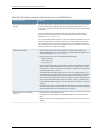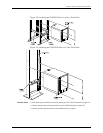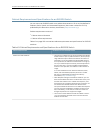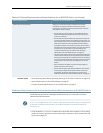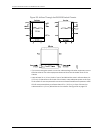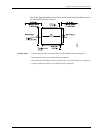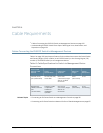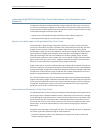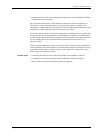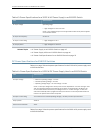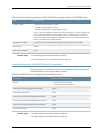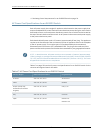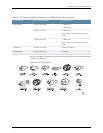
Understanding EX8200 Switch Fiber-Optic Cable Signal Loss, Attenuation, and
Dispersion
To determine the power budget and power margin needed for fiber-optic connections,
youneedtounderstandhowsignalloss,attenuation,anddispersionaffecttransmission.
JuniperNetworksEX8200EthernetSwitchesusevarioustypesofnetworkcable,including
multimode and single-mode fiber-optic cable.
•
Signal Loss in Multimode and Single-Mode Fiber-Optic Cable on page 106
•
Attenuation and Dispersion in Fiber-Optic Cable on page 106
Signal Loss in Multimode and Single-Mode Fiber-Optic Cable
Multimode fiber is large enough in diameter to allow rays of light to reflect internally
(bounce off the walls of the fiber). Interfaces with multimode optics typically use LEDs
as light sources. However, LEDs are not coherent light sources. They spray varying
wavelengths of light into the multimodefiber, which reflectsthe lightat different angles.
Light rays travel in jagged lines through a multimode fiber, causing signal dispersion.
When light traveling in the fiber core radiates into the fiber cladding (layers of lower
refractive indexmaterial in close contact with a core material of higher refractive index),
higher-order mode loss (HOL) occurs. Together, these factors reduce the transmission
distance of multimode fiber compared to that of single-mode fiber.
Single-mode fiber is so small in diameter that rays of light reflect internally through one
layeronly.Interfaceswith single-modeoptics uselasersaslight sources.Lasersgenerate
asinglewavelength oflight, whichtravelsin astraightlinethroughthe single-modefiber.
Compared to multimode fiber, single-mode fiber has a higher bandwidth and can carry
signals for longer distances. It is consequently more expensive.
For information about the maximum transmission distance and supported wavelength
range forthe typesof single-modeand multimodefiber-optic cablesthatare connected
tolinecardsontheEX8200switches,see“OpticalInterfaceSupportinEX8200Switches”
on page 60. Exceeding the maximum transmission distances can result in significant
signal loss, which causes unreliable transmission.
Attenuation and Dispersion in Fiber-Optic Cable
Anopticaldatalinkfunctionscorrectlyprovidedthatmodulatedlightreachingthereceiver
has enough power to be demodulated correctly. Attenuation is the reduction in strength
of the light signal during transmission. Passive media components such as cables, cable
splices, and connectors cause attenuation. Although attenuation is significantly lower
for optical fiber than for other media, it still occurs in both multimode and single-mode
transmission. An efficient optical data link must transmit enough light to overcome
attenuation.
Dispersion is the spreading of the signal overtime. Thefollowing two types of dispersion
can affect signal transmission through an optical data link:
•
Chromatic dispersion, which is the spreading of the signal over time caused by the
different speeds of light rays.
Copyright ©2010,Juniper Networks,Inc.106
CompleteHardwareGuide forEX8208 EthernetSwitches



